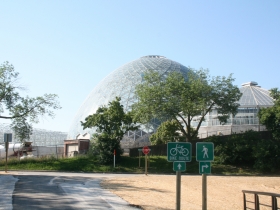Rumors of Domes’ Demise Exaggerated
Despite report recommending their death, county board members want to save domes.
Despite the news of a report calling for demolition of the Mitchell Park Domes, Milwaukee County has no such plans.
Gallagher Museum Services, based in Ohio, studied the feasibility of co-locating the Milwaukee Public Museum in Mitchell Park with the Mitchell Park Horticultural Conservatory. In their report they recommended demolishing the domes in order to bring the museum to Mitchell Park. The Public Museum says its current facility is outmoded and it hopes to build a new one.
The study was the product of a budget amendment during the last budget cycle. The idea was a pragmatic one: move the museum to Mitchell Park on land the county already owns. The study is one among several being used by the Domes Task Force, and is also of interest to the task force created to help find a new home for the public museum.
The domes are a sacred cow in Milwaukee County for elected officials and residents. Said Supervisor Steven Shea: “The thought of tearing down the domes pains me and I know a lot of other residents to Milwaukee County.”
Board Chairman Theo Lipscomb echoed his colleagues, declaring: “The Domes Task Force remains engaged in a more extensive analysis than this recent study and they are charged with drafting recommendations that I believe will lead to the repair and preservation of the Domes.”
The study that called for demolishing the domes technically came out of the Task Force for the public museum. Its narrow focus was how could the Milwaukee Public Museum be moved to Mitchell Park. What it found was, yes, it could be moved there; and if it was, it could become a combined facility marrying the horticultural experience with the museum’s natural history exhibits.
This would mean taking down the domes. And spending $267 million to develop the new institution. The recommendation being a 300,000 square foot facility, much smaller than the current museum (roughly 500,000 square feet). The smaller footprint would save an estimated $75 million in development costs. The Gallagher study also estimates that the new combined facility would save $600,000 or more annually, compared to combined annual costs of the two facilities as they currently stand.
Recent years have seen fluctuations up and down in attendance, but since at least the early 1970s attendance has been steadily declining for the domes. Attendance is a significant part of the domes puzzle, as admission revenue has made up more than 80 percent of revenue to the domes in recent years, according to an audit released in Dec. 2018 by the Milwaukee County Office of the Comptroller. So in 2016, when the domes were temporarily closed for repairs, total revenue dropped by more than 60 percent.
But attendance is not the only problem facing the domes. The audit highlighted a number of operational areas requiring review. And a feasibility and future report from spring 2018 outlining eight possible options for the domes future said in its opening pages that the “Mitchell Park Horticultural Conservatory lacks the staff, programming, a relevant governance structure, and versatile spaces needed for success in today’s market. These conditions make the Domes unsustainable for operations and for future maintenance of the facility.”
Still, they remain a unique horticultural exhibit, with a desert dome, a tropical dome and a floral show-dome. And the glass domes, according to the conservatory, are the only such structures in the world with a conoidal shape.
Between 2015 and 2018 Milwaukee County spent $1.5 million on domes-related projects, the majority of which was spent on long range planning. The domes task force is expected to release a final long term plan for the domes by September. If that plan is adopted by the County Board, they will fund the future of the domes accordingly.
The Parks and Recreation Department under the Abele administration does not have a particular position on the domes, said Ian Everett, the department’s communication manager. He added that before a final report or decision can be made, there is still information the county needs to collect.
In the past Abele called tearing down the domes a “realistic option”. In 2016, Abele told Dan Bice of the Milwaukee Journal Sentinel, “If the public says, ‘Hey, we don’t want to spend, of the finite box of funding we have, we don’t want to spend on this $75 million,’ I’m not going to tell them they’re wrong.”
Abele said in that interview with Bice, “To me, the most important thing is, whatever we do there, it serves people. It’s what the public and the community wants to see there. And then, within that context, it’s the most sustainable and efficient.”
The board, and the task force are still collecting information on their options. Recently, Jennifer Sandy with the National Trust for Historic Preservation went before the parks committee and explained how Milwaukee County could use historic tax credits to fund up to 20 percent of rehabilitation efforts. Though an important caveat to the tax credits would be the domes governance structure. That is, the domes would require some form of a public-private partnership. This could mean leasing the domes to a for-profit entity (which could apply for the credits), potentially one owned by a non-profit. The ConsultEcon/HGA report also highlighted the domes current governance structure as a barrier to private investment and historic tax credits.
So, despite the recommendations of the single study, the options for the future of the domes are still wide open. Or at least, as open as Milwaukee County’s wallet.
The Domes
If you think stories like this are important, become a member of Urban Milwaukee and help support real independent journalism. Plus you get some cool added benefits, all detailed here.
More about the Future of The Domes
- MKE County: Domes Plan Requires $30 Million From County - Graham Kilmer - Jul 2nd, 2025
- MKE County: Domes Project Lining Up Key Financing Component - Graham Kilmer - Feb 28th, 2025
- MKE County: Supervisor Adds Domes Project to 2025 Budget - Graham Kilmer - Oct 24th, 2024
- Supervisor Martinez Budget Amendment Advances “Domes Reimagined” Proposal - Sup. Juan Miguel Martinez - Oct 24th, 2024
- MKE County: Domes Group Proposes $133 Million Repair, Redevelopment - Graham Kilmer - Sep 3rd, 2024
- MKE County: New Domes Plan Expected This Summer - Graham Kilmer - Apr 22nd, 2024
- MKE County: New Plan Emerging To Save The Domes - Graham Kilmer - Nov 16th, 2023
- MKE County: Domes Costs Shock Supervisors - Graham Kilmer - Sep 12th, 2023
- Op Ed: Don’t Despair About the Domes - Emma Rudd - Aug 16th, 2023
- MKE County: Parks Launches Mitchell Park Campaign - Graham Kilmer - Jul 31st, 2023
Read more about Future of The Domes here
MKE County
-
J.D. Vance Plays Up Working Class Roots, Populist Politics in RNC Speech
 Jul 17th, 2024 by Graham Kilmer
Jul 17th, 2024 by Graham Kilmer
-
Ron Johnson Says Free-Market Principles Could Fix Education
 Jul 17th, 2024 by Graham Kilmer
Jul 17th, 2024 by Graham Kilmer
-
RNC Will Cause Some County Services To Be Moved to Wauwatosa
 Jul 12th, 2024 by Graham Kilmer
Jul 12th, 2024 by Graham Kilmer




























